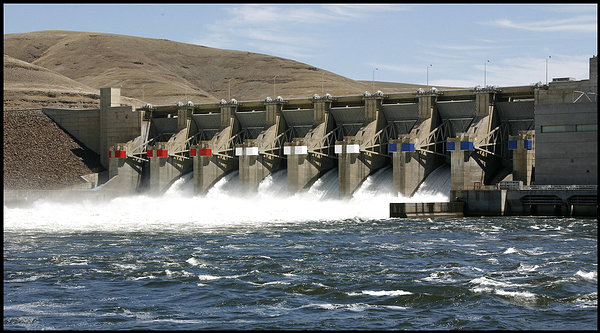forum
library
tutorial
contact

Big Water Mainstem: Runoff Supply Forecasts
Continue To Rise At Columbia, Snake River Dams
by Staff
Columbia Basin Bulletin, April 14, 2017
|
the film forum library tutorial contact |

|
Big Water Mainstem: Runoff Supply Forecasts
by Staff
|
 Water supply forecasts at two major dams on the Columbia and Snake rivers have risen since the official water supply forecasts were set in early April.
Water supply forecasts at two major dams on the Columbia and Snake rivers have risen since the official water supply forecasts were set in early April.
The Lower Granite Dam April through July water supply forecast on the Snake River, which was 143 percent of normal (30-year average), has risen 2 percent to 145 percent of normal, and the forecast at The Dalles Dam, April through August, has risen 3 percent to 123 percent of normal, according to information presented by Tony Norris of the Bonneville Power Administration at this week's interagency Technical Management Team meeting, Wednesday, April 12.
The official April through July forecast for Lower Granite Dam, issued April 4, was 28.373 million acre feet, 143 percent of normal, but that changed as of April 13 to 28.685 MAF, 145 percent of normal.
The official forecast for The Dalles Dam, issued April 4, was 105.039 MAF, April through August, 120 percent of normal. That also has changed to 107.696 MAF, 123 percent of normal.
The official April through August forecast for Libby Dam in Montana, issued April 4, was 7.654 MAF, 130 percent of normal.
Dworshak Dam's water supply forecast, April through July, was set April 4 at 2.984 MAF, which is 122 percent of normal. The Dam is on the North Fork of the Clearwater River, a tributary of the Snake River upstream of Lower Granite Dam. The Corps, which operates the dam, is aiming at an elevation of 1,450 feet by April 15 to meet its flood control target. On April 1 the elevation was at 1,525 feet.
Grand Coulee Dam's water supply forecast was set April 4 at 64.955 MAF, April through August, which is 114 percent of normal. The current elevation at Lake Roosevelt, the lake impounded behind the dam, is about 1,238 feet, according to Bureau of Reclamation information. BOR operates the dam . It must reach 1,222.7 feet by the end of April to meet its flood control target.
The Albeni Falls water supply forecast, April through August, is 15.596 MAF, 126 percent of normal.
The Hungry Horse water supply forecast is 1.955 MAF, April through July, which is 105 percent of normal
Official water supply forecasts for these dams from the U.S. Army Corps of Engineers are at www.nwd-wc.usace.army.mil/tmt/documents/WSF/
Norris said that the outlook for temperature and precipitation likely will not alter snow or water forecasts in the near future.
NOAA's 6 to 10 day forecast in most of the Columbia River basin is for lower than average temperatures and higher than average precipitation, and that doesn't change or improve looking out to 14 days (see NOAA Climate Forecasts).
Over the long-haul, out 30 days, there is an equal chance of near normal temperature, Norris said. As for precipitation, rain west of the Cascade Mountains will likely be above average, but near normal east of the Cascades, he said.
Relating to high water this week, a fish separator system at the Little Goose Lock and Dam Juvenile Fish Facility became plugged and overflowed because of abnormally high seasonal debris from the lower Snake River, according to Corps officials. The plugging and overflowing caused the death of 94 juvenile salmon and steelhead.
The juvenile collection system and separator routes juvenile fish for sampling, barging or release back into the river. The inadvertent plugging and overflow occurred at about 1:30 p.m. on Tuesday. The Corps had been periodically checking the juvenile bypass system for operational compliance when the plugging and overflow occurred.
Once the problem was discovered, and to prevent further overflow and fish mortality, a "switch gate" in the separator system was moved to a bypass position until debris could be removed, routing fish around the blockage. Juvenile fish separation and sampling resumed at about 2:30 p.m.
To help prevent future incidents, the Corps will maintain increased monitoring of the system. Also, on April 12, the separator was disassembled to remove additional debris.
Little Goose has seen higher-than-normal debris come through the area.
learn more on topics covered in the film
see the video
read the script
learn the songs
discussion forum
